Armenia–Georgia relations
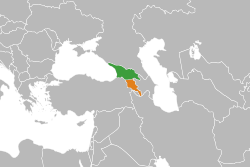 |
|
Georgia |
Armenia |
|---|---|
Armenian–Georgian relations refers to foreign relations between Armenia and Georgia. Both countries were former Soviet Republics of the former USSR. Armenia and Georgia governments have had generally positive relations, but there have also been some problems in the past. Georgia is a member of GUAM, which leaves Armenia out of regional transportation and energy projects.
Relations with Georgia are of particular importance for Armenia because, under the illegal border blockade imposed by Turkey and Azerbaijan due to the Nagorno-Karabakh conflict, Georgia offers Armenia its only land connection with Europe and access to its Black Sea ports. However, because of Armenia's reliance on Russia and Georgia, both of whom fought in the 2008 South Ossetia war and severed diplomatic and economic relations as a result; and as 70% of Armenia's imports entered via Georgia especially from Russia which has imposed an economic blockade on Georgia. Armenian President Serzh Sargsyan has stated that Armenia will not formally recognize Abkhazia and South Ossetia as independent states any time soon but reiterated his support for their residents’ right to self-determination, while adding that Armenia cannot recognise another entity in the same situation as long as it has not recognised the Nagorno-Karabakh Republic.[1] Georgia supports resolution of Nagorno-Karabakh conflict within Azerbaijan's territorial integrity. Georgian State Minister for Diaspora Affairs Mirza (Papuna) Davitaia has stated that Georgia has unilaterally supported the territorial integrity of Azerbaijan and they back the liberation of the occupied territories of Azerbaijan.[2] Former Georgian President Mikheil Saakashvili stated that "whoever opposes Azerbaijan" is Georgia's "enemy." [3]
The Javakheti region in southern Georgia contains a large Armenian population and although there have been local civic organizations (such as United Javakhk) pushing for autonomy, there has been no violence between Armenians and Georgians in the area. The border problem over Javakheti resulted in Georgian-Armenian War 1918. The Georgian-Abkhazian conflict, which is believed by many Georgians to have been backed by Russia with Armenian assistance, has caused many problems for Georgia, as the War in Abkhazia resulted in thousands of ethnic Georgians killed and Armenians living in Abkhazian region sided with local Abkhazians.[4][5] Since independence Georgian clergy have occupied the Armenian churches.[6] Armenians in Georgia and Armenia have demonstrated against the destruction. On November 28, 2008, Armenian demonstrators in front of the Georgian embassy in Armenia demanded that the Georgian government immediately cease encroachments on the Armenian churches and punish those guilty, calling the Georgian party's actions White Genocide.[7] Some Armenians believe they are victims of a policy to shift the Samtskhe-Javakheti region's demographic balance as a number of Georgian families were settled there and Armenians are also underrepresented in the government leading to the perception of discrimination and mutual distrust. There were several protests, and some of them turned violent after clashes with law enforcement agents.[8] Georgia also supported Azerbaijan against to Armenia in United Nations General Assembly Resolution 62/243. Despite the stated differences, disagreements and conflicting interests, bilateral relations between the two countries are stable and developing.
Minorities
There are nearly 168,102 Armenians in Georgia, among them 81,089 living in Javakheti and 53,409 in Tbilisi.[9] The Georgian minority in Armenia stands at 974 according to the 2011 Census in Armenia.
History
Armenia and Georgia have a long history of cultural and political relations. The interaction peaked in the Middle Ages when both nations engaged in prolific cultural dialogue and allied themselves against the neighboring Muslim empires. There were frequent intermarriages between Armenian and Georgian the royal and noble families and both ethnicities intermingled in several border areas.
The Roman Conquest

This close association with Armenia brought upon the country an invasion (65 BC ) by the Roman general Pompey, who was then at war with Mithradates VI of Pontus, and Armenia; but Rome did not establish her power permanently over Iberia. Nineteen years later, the Romans again marched (36 BC) on Iberia forcing King Pharnavaz II to join their campaign against Albania.[10]
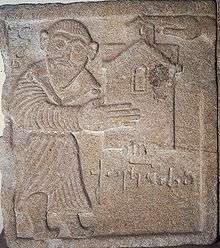
During this time Armenia and Pontus were actively expanding at the expense of Rome, taking over its Eastern Mediterranean possessions. However, the success of the anti-Roman alliance did not last long. As a result of the brilliant Roman campaigns of Pompey and Lucullus from the west, and the Parthian invasion from the south, Armenia lost a significant part of its conquests by 65 BC, devolving into a Roman-Parthian dependency. At the same time, the Kingdom of Pontus was completely destroyed by the Romans and all its territory including Colchis were incorporated into the Roman Empire as her provinces.
The former Kingdom of Colchis became the Roman province of Lazicum ruled by Roman legati. The following 600 years of Georgian history were marked by struggle between Rome and Persia (Iran) including Parthians and Sassanids who were fighting long wars against each other for the domination in the Middle East including Syria, Mesopotamia, Armenia, Albania, and Iberia.
In the 2nd century AD, Iberia strengthened her position in the area, especially during the reign of King Pharsman II who achieved full independence from Rome and reconquered some of the previously lost territories from declining Armenia. In the early 3rd century, Rome had to give up Albania and most of Armenia to Sassanid Persia. The province of Lazicum was given a degree of autonomy that by the end of the century developed into full independence with the formation of a new Kingdom of Lazica-Egrisi on the territories of smaller principalities of the Zans, Svans, Apsyls, and Sanyghs. This new Western Georgian state survived more than 250 years until 562 when it was absorbed by the Byzantine Empire.
While the Georgian kingdom of Colchis was administered as a Roman province, Caucasian Iberia freely accepted the Roman Imperial protection. A stone inscription discovered at Mtskheta speaks of the 1st-century ruler Mihdrat I (AD 58-106) as "the friend of the Caesars" and the king "of the Roman-loving Iberians." Emperor Vespasian fortified the ancient Mtskheta site of Arzami for the Iberian kings in 75 AD.
In the 2nd century AD, Iberia strengthened her position in the area, especially during the reign of King Pharsman II who achieved full independence from Rome and reconquered some of the previously lost territories from declining Armenia.
In the 3rd century AD, the Lazi tribe came to dominate most of Colchis, establishing the kingdom of Lazica, locally known as Egrisi. Colchis was a scene of the protracted rivalry between the Eastern Roman/Byzantine and Sassanid empires, culminating in the Lazic War from 542 to 562.[11]
Middle Ages
Bagrationi Kingdom
.jpg)
The first decades of the 9th century saw the rise of a new Georgian state in Tao-Klarjeti. Ashot Courapalate of the royal family of Bagrationi liberated from the Arabs the territories of former southern Iberia. These included the Principalities of Tao and Klarjeti, and the Earldoms of Shavsheti, Khikhata, Samtskhe, Trialeti, Javakheti and Ashotsi, which were formally a part of the Byzantine Empire, under the name of "Curopalatinate of Iberia". In practice, however, the region functioned as a fully independent country with its capital in Artanuji. The hereditary title of Curopalates was kept by the Bagrationi family, whose representatives ruled Tao-Klarjeti for almost a century. Curopalate David Bagrationi expanded his domain by annexing the city of Theodossiopolis (Karin, Karnukalaki) and the Armenian province of Basiani, and by imposing a protectorate over the Armenian provinces of Kharqi, Apakhuni, Mantsikert, and Khlat, formerly controlled by the Kaysithe Arab Emirs.
Seljuq invasion
The second half of the 11th century was marked by the strategically significant invasion of the Seljuq Turks, who by the end of the 1040s had succeeded in building a vast nomadic empire including most of Central Asia and Persia. In 1071, the Seljuq army destroyed the united Byzantine-Armenian and Georgian forces in the Battle of Manzikert. By 1081, all of Armenia, Anatolia, Mesopotamia, Syria, and most of Georgia had been conquered and devastated by the Seljuqs. By the end of the 1080s, Georgians were outnumbered in the region by the invaders. The defeat of the Bagratuni Dynasty ended Christian leadership of Armenia for the next millennium.
King David IV the Builder and Georgian Reconquista
The struggle against the Seljuq invaders in Georgia was led by the young King David IV Bagrationi (reigning 1089-1125).
In 1121, the Seljuq Sultan Mahmud declared Jihad on Georgia and sent a strong army under one of his famous generals Ilghazi to fight the Georgians. Although significantly outnumbered by the Turks, the Georgians managed to defeat the invaders at the Battle of Didgori, and in 1122 they took over Tbilisi, making it Georgia's capital. Three years later the Georgians freed Shirvan and a large portion of Armenia. Thus in 1124 David also became the King of Armenians, incorporating Northern Armenia into the lands of the Georgian Crown. In 1125 King David died, leaving Georgia with the status of a strong regional power.
Queen Tamar the Great of Georgia

The reign of Queen Tamar represented the peak of Georgia's might in the whole history of the nation. In 1194-1204 Tamar's armies crushed new Turkish invasions from the south-east and south and launched several successful campaigns into Turkish-controlled Southern Armenia. As a result, most of Southern Armenia, including the cities of Karin, Erzinjan, Khelat, Muş and Van, came under Georgian control. Although it was not included in the lands of the Georgian Crown, and was left under the nominal rule of local Turkish Emirs and Sultans, Southern Armenia became a protectorate of the Kingdom of Georgia. The temporary fall of the Byzantine Empire in 1204 to the Crusaders left Georgia as the strongest Christian state in the whole East Mediterranean area. Muslim power in Greater Armenia was seriously troubled by the resurgent Georgian monarchy. Many local nobles (nakharars) joined their efforts with the Georgians, leading to liberation of several areas in northern Armenia (Zakarid Armenia), which was ruled, under the authority of the Georgian crown, by the Zakarids/Mkhargrdzeli, a prominent Armeno-Georgian noble family.
Mongol invasions
The kingdom of Georgia flourished during the 10th to 12th centuries, and fell to the Mongol invasions of Georgia and Armenia by 1243, and after a brief reunion under George V of Georgia to the Timurid Empire.
Ottoman and Persian domination
By 1490, Georgia was fragmented into a number of petty kingdoms and principalities, which throughout the Early Modern period struggled to maintain their autonomy against Iranian (successive Safavid, Afsharid and Qajar dynasties) and Ottoman domination until Georgia was finally annexed by the Russian Empire in 1801. Russian possession over Georgia got nominally finalised with Qajar Iran in 1813 in the Treaty of Gulistan following Russia's victory in the Russo-Persian War (1804-1813).[12] Greater Armenia was from the early 16th century up to including the course of the 19th century was also, more dominantly even, divided between the rivalling neighboring Ottoman and successive Iranian dynasties. In the first half of the 19th century, after several centuries under its rule in the early modern era, Iran was forced to cede its last remaining territories in the Caucasus which included modern-day Armenia (also known as Eastern Armenia) to Imperial Russia following its loss in the Russo-Persian War (1826-1828), which got ratified in the 1828 Treaty of Turkmenchay.[13] Greater Armenia was now divided between the Ottoman Empire and Russia.
Provinces of the Russian Empire
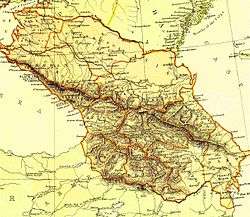
.
Transcaucasian Federation (1917-1918)
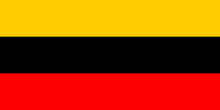
During the Russian Revolution, the provinces of the Caucasus seceded and formed their own federal state called the Transcaucasian Federation. Competing national interests and war with Turkey led to the dissolution of the republic half a year later, in April 1918.
Georgian-Armenian War (1918)
During the final stages of World War I, the Armenians and Georgians had been defending against the advance of the Ottoman Empire. In June 1918, in order to forestall an Ottoman advance on Tiflis, the Georgian troops had occupied the Lori Province which at the time had a 75% Armenian majority. After the Armistice of Mudros and the withdrawal of the Ottomans, the Georgian forces remained. Georgian Menshevik parlementarian Irakli Tsereteli offered that the Armenians would be safer from the Turks as Georgian citizens. The Georgians offered a quadripartite conference including Georgia, Armenia, Azerbaijan, and the Mountainous Republic of the Northern Caucasus in order to resolve the issue which the Armenians rejected. In December 1918, the Georgians were confronting a rebellion chiefly in the village of Uzunlar in the Lori region. Within days, hostilities commenced between the two republics.[14]
The Georgian-Armenian War was a border war fought in 1918 between the Democratic Republic of Georgia and the Democratic Republic of Armenia over the parts of then disputed provinces of Lori, Javakheti which had been historically bicultural Armenian-Georgian territories, but were largely populated by Armenians in the 19th century.
As Soviet republics
Transcaucasian SFSR (1922-1936)
From March 12, 1922 to December 5, 1936, Armenia and Georgia were a part of the Transcaucasian SFSR together with the Azerbaijan SSR. In 1936, the TSFSR was dissolved under Stalin's orders and the socialist republics of Armenia, Azerbaijan, and Georgia were established instead.
Armenian SSR and Georgian SSR (1936-1991)
In the Soviet Union, Armenians and Georgians, along with Russians, Ukrainians, Belarusians, Germans, and Jews were judged as "advanced" peoples, and were grouped together as Western nationalities.[15]
Nevertheless, as with various other ethnic minorities who lived in the Soviet Union under Stalin, tens of thousands of Armenians were executed and deported. In 1936, Lavrenty Beria and Stalin worked to deport Armenians to Siberia in an attempt to bring Armenia's population under 700,000 in order to justify an annexation into Georgia.[16]
-

Flag of Transcaucasian SFSR
-
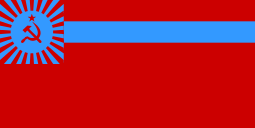
Flag of Georgian SSR
-
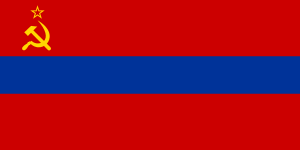
Flag of Armenian SSR
As independent states
On March 17, 1991, Armenia, along with the Baltics, Georgia and Moldova, boycotted a union-wide referendum in which 78% of all voters voted for the retention of the Soviet Union in a reformed form.[17]
Armenia declared independence on 23 August 1990 and Georgia did the same on 9 April 1991. The United States recognized both independence of the nations on December 25, 1991.
Armenian-Georgian relations in the post-independence period have been mixed but cooperative. The two states are each one allied with the other one's enemies (Armenia with Russia, Georgia with Azerbaijan and Turkey), but they are nevertheless obliged to maintain cooperative ties: the closure of the Turkish and Azeri borders of Armenia makes Georgia (and, via a single route, Iran) the only possible trade partner of Armenia.
Recent revelations indicate that Yerevan had taken steps to assure Tbilisi that it had Armenia's all-but-official support in the outbreak of the 2008 South Ossetian and Abkhazian conflict. Armenia offered itself as a safe haven for Georgians escaping the conflict, and at one point, temporarily housed at least 500 Georgian families escaping the war. To this day, Armenia has not recognized South Ossetia and Abkhazia as independent states.
According to Wikileaks, however, Armenia's foreign diplomats grew increasingly frustrated with Tbilisi's inability to respond to calls or diplomatic cables from Yerevan.[18] Despite their reluctance to warmly embrace each other diplomatically, the differences between the two nations are more often highlighted by political rather than social or historical differences.
Positive steps have been taken to strengthen ties between the two nations. In January 2011, Georgian President Mikhail Saakashvilli paid an official visit to Armenia immediately after his initial visit to Washington. Both the Georgian and Armenian presidents seem to hold each other to a high esteem, and Georgia's push to remove itself from the Russian sphere of influence in the Caucasus Region has translated to an increase of cooperation, positivity and productivity in relations with its immediate neighbors. Tbilisi recently made an effort to address the socioeconomic plight of the Georgian-Armenians living in Javakheti, a source of tension between the two nations, by building a main road that connects the region with Tbilisi as well as proposing new projects in the region, one of which involves the creation of a national park.
On June 18, 2013, a small clash took place near the Dinamo Arena, Tbilisi after a friendly match between Armenia's and Georgian's champions Shirak F.C. and FC Dinamo Tbilisi.[19] The Georgian police prevented further escalation.[20]
See also
References
- ↑ Armenia Rules Out Abkhazia, South Ossetia Recognition
- ↑ Georgia supports resolution of Nagorno-Karabakh conflict within Azerbaijan's territorial integrity
- ↑ Whoever opposes Azerbaijan is Georgia's "enemy"
- ↑ AGBU, ABKHAZIA ARMENIANS: HOLDING A HOME IN AN UNSTABLE TERRITORY, 11/1/2004
- ↑ The Security of the Caspian Sea Region pg 286 by Alexander Kyrlov edited by Genadi Chufrin
- ↑ "Armenians of Georgia urge to stop barbarous destruction of Armenian cultural heritage". PanArmenian.net. Retrieved 2008-11-29.
- ↑ "PROTEST ACTION AGAINST ENCROACHMENTS ON ARMENIAN CHURCHES IN GEORGIA HELD IN YEREVAN". defacto.am. Retrieved 2008-11-29.
- ↑ Reuters AlertNet - Georgia’s Armenian and Azeri Minorities
- ↑ 2002 Georgia census Archived August 31, 2006, at the Wayback Machine..
- ↑ Braund, D., Georgia in Antiquity: A History of Colchis and Transcaucasian Iberia 550 BC – AD 562, Oxford University Press, 1996, p 36
- ↑ History of the later Roman Empire: The Lazic war
- ↑ Timothy C. Dowling Russia at War: From the Mongol Conquest to Afghanistan, Chechnya, and Beyond pp 728-729 ABC-CLIO, 2 dec. 2014 ISBN 1598849484
- ↑ Timothy C. Dowling Russia at War: From the Mongol Conquest to Afghanistan, Chechnya, and Beyond pp 728-729 ABC-CLIO, 2 dec. 2014 ISBN 1598849484
- ↑ Armenian the Survival of a Nation, Christopher Walker pg 267-268
- ↑ Martin, Terry (2001). The Affirmative Action Empire: Nations and Nationalism in the Soviet Union, 1923-1939. New York: Cornell University, p. 23. ISBN 0-8014-8677-7.
- ↑ Bauer-Manndorff, Elisabeth (1981). Armenia: Past and Present. New York: Armenian Prelacy, p. 178.
- ↑ "Baltic states, Armenia, Georgia, and Moldova boycott USSR referendum.". Archived from the original on November 16, 2005. Retrieved 2007-02-06.
- ↑ http://massispost.com/?p=981
- ↑ "Dinamo vs. Shirak: Georgian fans assault Armenian sportsmen after home match". Tert.am. 18 June 2013. Retrieved 22 June 2013.
- ↑ "Fight between Georgian and Armenian fans after a friendly match". Georgianews. 18 June 2013. Retrieved 22 June 2013.
External links
- Historic Concern: Georgian Armenians say authorities out to rid country of Armenian traces
- Georgia is becoming hostage to Azeri-Turkish alliance: interview with Pavel Chobanyan by Pavel Chobanyan – expert of the Caucasus analytical center, doctor of historical sciences
- (Italian) gli amici dei nemici, Osservatorio Balcani e Caucaso, 20 gennaio 2011

